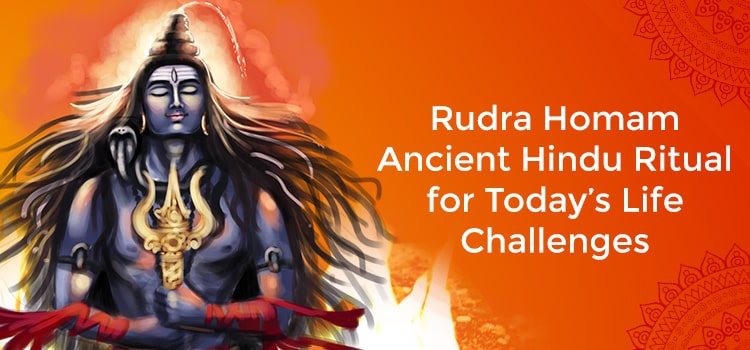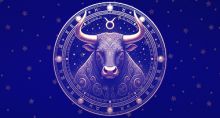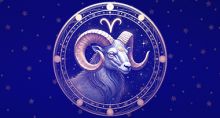Rudra Homam: Ancient Hindu Ritual for Today’s Life Challenges
Rudra is a form of Shiva, the Destroyer Archetype in the Hindu religion. He is a fierce form of Shiva. In Sanskrit, ‘Rudra’ means ‘the roarer’. It also denotes ‘roaring storm’, ‘fierce,’ and ‘destruction’.
While Shiva means ‘the ‘auspicious one’, Rudra means the opposite.
Origin of Rudra
There are different legends relating to the origin of Rudra.
The Shiva Purana says that Brahma asked Shiva to create some other beings as he was bored of creating ordinary mortals. So Shiva created 11 forms of Rudra. They are Kapali, Pingala, Bhima, Virupaksa, Vilohita, Ajesha, Shasana, Shasta, Shambhu, Chanda and Bhav.
Since Shiva created them, he is also called Rudra. The Rig Veda refers to him as Rudra. The Rudras fight demons and protect the Gods.
Another legend says that Indra, the king of the Gods, who dwelt in the city of Amaravati Puri, was defeated by the demons and had to flee the city along with the other gods. The deities went to the ashram of Sage Kashyap, the father of Indra.

The Gods asked for his help. The sage made a Shivlingam and started to meditate. Pleased by his meditation, Shiva appeared before him and asked him to make a wish. The sage wanted Shiva to be born as his son, and Shiva agreed. The sage’s wife gave birth to 11 sons. They were forms of Shiva and were called Rudras. The Bhagavad Gita also refers to Shiva as Rudra.
The Vishnu Purana says that Rudra emerged from Brahma’s eyebrows and was created from the rage of Brahma. After Brahma created his sons, he asked them to do the same. His sons desired liberation and refused to do so. This made Brahma angry. His anger came between his eyebrows and emerged as Rudra. The infant cried and asked Brahma to give him a name and place. Brahma gave him the name, Rudra, as well as 11 other names. Shiva is also referred to as Lord Shiva Rudra.
There are many ways to worship Shiva, and Rudra Homam is one of them.
In Rudra Homam, the procedures involve chanting Mantras, offering prayers, and making offerings of herbs, ghee, and other items into the sacred fire. When performed properly, it can remove obstacles and negative karma, thereby purifying our minds and souls.
Homam is a Vedic ritual that uses fire to connect with the deities.
It is performed by lighting a fire with certain sacred materials. The priest invokes cosmic energy in the Homam fire through prayer and visualization. The fire becomes energized by the chanting of Mantras. The energy moves upward and outward into the atmosphere. The Homam cleanses and rejuvenates the environment by creating an abundant flow of prana (life force) into the atmosphere.
The fire (Agni) of the Homam awakens the Jataragni (inner fire) within us, which enables proper digestion of food and dissemination of food energy. The Siddha-Ayurvedic herbs that are offered into the Homam fire create vibrations that reach our deeper energy layers. It is said that the smoke from a sacred Homam can cure diseases like asthma. The sacred ash from the Homam acts as a repository of energy. It can heal many diseases when applied to the skin.
Sri Rudram is a powerful Vedic hymn on Shiva. Found in the Yajur Veda, it is known for its healing vibrations. When chanted, it can invoke Shiva’s energy, intelligence, and blessings. Sri Rudram describes the cosmic form of Shiva.
Rudra is the God of anti-aging. It represents Shiva’s rejuvenating energy which can make one younger. Sri Rudram is also called Namakam. It contains 300 repetitions of the word ‘Namaha,’ which in Sanskrit means ‘salutations’.
Another meaning is ‘not me’. Uttering the word ‘not me’ or 'namaha' repeatedly strikes at the root of the ego directly. Ego causes many of our problems. Our brain responds differently to different words. Repeating ‘namaha’ breaks the unconscious part of our mind, where all health problems originate. By chanting the Sri Rudram with awareness, we can destroy the root of all health problems.
During the Rudrabhishekam, priests chant Chamakam after Namakam. Chamakam is a Vedic hymn that is chanted for health and prosperity. It is a very auspicious chant and is usually chanted during marriages, housewarming ceremonies, etc.
Significance of Performing Rudra Homam
The human body has more than 72,000 subtle energy channels or Nadis. These Nadis are closely associated with the working of the nervous system. Negative energies block the free flow of prana (life force) in the Nadis. This causes many ‘incurable’ or ‘karmic’ diseases, including mental disorders.
When Rudra Homam is performed with devotion and awareness, its energy can penetrate our deepest energy layers, energize the nadis and eliminate the negative samskaras (engraved memories) which affect our health and minds. Also, the high consciousness in the atmosphere in an energy field can put us into a meditative state.
Mediation activates the self-healing mechanism of the body, thereby acting as a remedy for disease that is curative and preventive.
When you perform Rudra Homam, the priest will chant a special Sankalpa Mantra in your name along with your prayer. This Sankalpa Mantra functions like a bridge between you and the energy and auspiciousness created by Rudra Homam. The effects and benefits of the Rudra Homam will be directly transferred to you through the Sankalpa Mantra. Thus, Rudra Homam will trigger the process of healing within you.
Benefits of Rudra Homa
It cleanses the mind and bestows good health
It gives courage to overcome obstacles
It helps fulfill wishes
It removes the fear of death
It can eliminate bad karma
It boosts wealth and success in business
It brings happiness in relationships



















